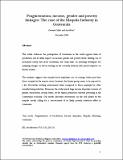| dc.description.abstract |
This article addresses the participation of Guatemala in the world apparel chain of production and its likely impact on income, gender and poverty levels. Making use of household survey data from Guatemala, the study relies on matching techniques for analyzing changes on labour earnings in the assembly industry with special emphasis on female workers. The evidence suggests that maquila-based employees are, on average, better paid than those occupied in the reserve sector, however, the former group seems to be exposed to a less favourable working environment when compared to those employed in other manufacturing industries. Moreover, the study reveals huge income disparities in terms of gender, exacerbated, among others, by the typical patriarchal structure prevailing in the Guatemalan economy. Our results introduce reservations on the role played by themaquila model, calling for a reassessment of its likely poverty reduction effect inGuatemala. |

